
Alice's Adventures in Wonderland is an 1865 English children's novel by Lewis Carroll, a mathematics don at Oxford University. It details the story of a young girl named Alice who falls through a rabbit hole into a fantasy world of anthropomorphic creatures. It is seen as an example of the literary nonsense genre. The artist John Tenniel provided 42 wood-engraved illustrations for the book.

The Hatter is a fictional character in Lewis Carroll's 1865 book Alice's Adventures in Wonderland and its 1871 sequel Through the Looking-Glass. He is very often referred to as the Mad Hatter, though this term was never used by Carroll. The phrase "mad as a hatter" pre-dates Carroll's works. The Hatter and the March Hare are referred to as "both mad" by the Cheshire Cat, in Alice's Adventures in Wonderland in the sixth chapter titled "Pig and Pepper".
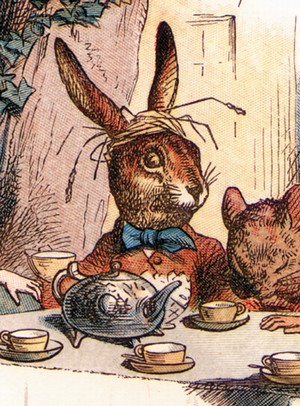
The March Hare is a character most famous for appearing in the tea party scene in Lewis Carroll's 1865 book Alice's Adventures in Wonderland.

The White Rabbit is a fictional and anthropomorphic character in Lewis Carroll's 1865 book Alice's Adventures in Wonderland. He appears at the very beginning of the book, in chapter one, wearing a waistcoat, and muttering "Oh dear! Oh dear! I shall be too late!" Alice follows him down the rabbit hole into Wonderland. Alice encounters him again when he mistakes her for his housemaid Mary Ann and she becomes trapped in his house after growing too large. The Rabbit shows up again in the last few chapters, as a herald-like servant of the King and Queen of Hearts.

Adventures in Wonderland is a 1992–1995 American live-action/puppet musical television series based on the novels Alice's Adventures in Wonderland (1865) and Through the Looking-Glass (1871) by Lewis Carroll as well as the 1951 animated film. In the series, Alice, is portrayed as a girl who can come and go from Wonderland simply by walking through her mirror.
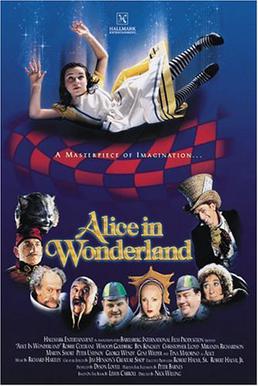
Alice in Wonderland is a 1999 made-for-television film adaptation of Lewis Carroll's books Alice's Adventures in Wonderland (1865) and Through the Looking-Glass (1871). It was first broadcast on NBC and then shown on British television on Channel 4.

Lewis Carroll's books Alice's Adventures in Wonderland (1865) and Through the Looking-Glass (1871) have been highly popular in their original forms, and have served as the basis for many subsequent works since they were published. They have been adapted directly into other media, their characters and situations have been appropriated into other works, and these elements have been referenced innumerable times as familiar elements of shared culture. Simple references to the two books are too numerous to list; this list of works based on Alice in Wonderland focuses on works based specifically and substantially on Carroll's two books about the character of Alice.

An unbirthday is an event celebrated on all days of the year which are not a person's birthday. It is a neologism which first appeared in Lewis Carroll's 1871 novel Through the Looking-Glass. The concept gave rise to "The Unbirthday Song" in the 1951 animated feature film Alice in Wonderland.

The Looking Glass Wars is a series of three novels by Frank Beddor, heavily inspired by Lewis Carroll's 1865 novel Alice's Adventures in Wonderland and its 1871 sequel Through the Looking-Glass. The premise is that the two books written by Lewis Carroll are a distortion of the "true story".

The Dormouse is a character in "A Mad Tea-Party", Chapter VII from the 1865 novel Alice's Adventures in Wonderland by Lewis Carroll.

The Knave of Hearts is a character from the 1865 book Alice's Adventures in Wonderland by Lewis Carroll.
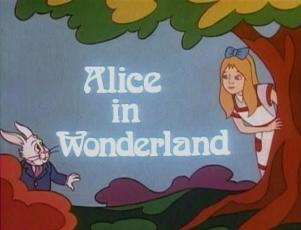
Alice in Wonderland is an Australian 51-minute direct-to-video animated film from Burbank Films Australia originally released in 1988.
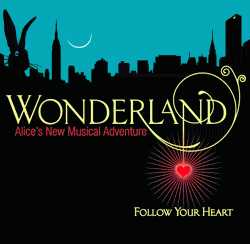
Wonderland, formerly called Wonderland: Alice's New Musical Adventure or Wonderland: A New Alice, is a musical play with a book by Jack Murphy and Gregory Boyd, lyrics by Murphy, and music by Frank Wildhorn. The story, a contemporary version of the novels Alice's Adventures in Wonderland (1865) and Through the Looking-Glass (1871) by Lewis Carroll, is set in New York City and focuses on writer Alice Cornwinkle and her 10-year-old daughter Chloe.

Alice in Wonderland is a 1949 French film based on Lewis Carroll's 1865 fantasy novel Alice's Adventures in Wonderland. Directed by Dallas Bower, the film stars Carol Marsh as Alice, Stephen Murray as Lewis Carroll, and Raymond Bussières as The Tailor. Most of the Wonderland characters are portrayed by stop-motion animated puppets created by Lou Bunin.

Alice in Wonderland is a 1915 American silent film adaptation of Lewis Carroll's classic 1865 novel, Alice's Adventures in Wonderland, directed and written by W. W. Young and starring Viola Savoy as Alice.
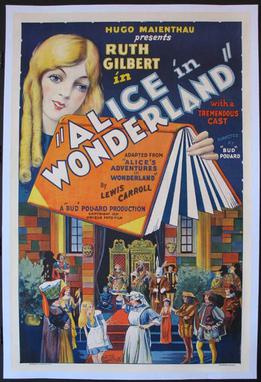
Alice in Wonderland (1931) is an independently made black-and-white Pre-Code American film based on Lewis Carroll's 1865 novel Alice's Adventures in Wonderland, directed by Bud Pollard, produced by Hugo Maienthau, and filmed at Metropolitan Studios in Fort Lee, New Jersey.
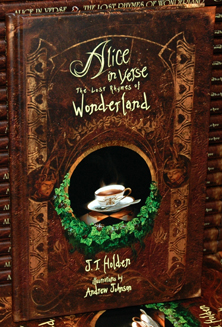
Alice in Verse: The Lost Rhymes of Wonderland (2010) is a reimagining of Lewis Carroll's 1865 novel Alice's Adventures in Wonderland written by British-American author J.T. Holden. It tells the story of Alice's Adventures in Wonderland in 19 rhyming poems, each written in the same style as Lewis Carroll's original verse. The book includes 36 illustrations by American artist Andrew Johnson.

Alice Through the Looking Glass is a 2016 American live-action/animated fantasy adventure film directed by James Bobin, written by Linda Woolverton and produced by Tim Burton, Joe Roth, Suzanne Todd, and Jennifer Todd. It is based on the characters created by Lewis Carroll and is the sequel to Disney's 2010 live-action feature film Alice in Wonderland. Johnny Depp, Anne Hathaway, Helena Bonham Carter, Matt Lucas, Mia Wasikowska, Alan Rickman, Stephen Fry, Michael Sheen, Barbara Windsor, Timothy Spall, Paul Whitehouse, Lindsay Duncan, Geraldine James, and Leo Bill reprise their roles from the previous film with Rhys Ifans and Sacha Baron Cohen joining the cast. It also features Rickman, Windsor, and Andrew Sachs in their final film roles prior to their deaths. In the film, a now 22-year-old Alice comes across a magical looking glass that takes her back to Wonderland, where she finds that the Mad Hatter is acting madder than usual and wants to discover the truth about his family. Alice then travels through time, comes across friends and enemies at different points of their lives, and embarks on a race to save the Hatter before time runs out.
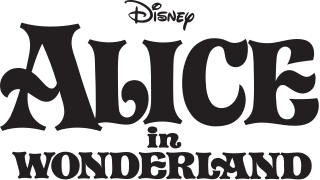
Alice in Wonderland, or simply Alice, is a Disney media franchise, commencing in 1951 with the theatrical release of the animated film Alice in Wonderland. The film is an adaptation of the books by Lewis Carroll, the 1865 novel Alice's Adventures in Wonderland and its 1871 sequel Through the Looking-Glass, which featured his character Alice. A live-action film directed by Tim Burton was released in 2010.

















